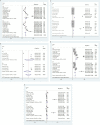Changes in the gut microbiota of patients with sarcopenia based on 16S rRNA gene sequencing: a systematic review and meta-analysis
- PMID: 39006102
- PMCID: PMC11239431
- DOI: 10.3389/fnut.2024.1429242
Changes in the gut microbiota of patients with sarcopenia based on 16S rRNA gene sequencing: a systematic review and meta-analysis
Abstract
Introduction: Sarcopenia, an age-related disease, has become a major public health concern, threatening muscle health and daily functioning in older adults around the world. Changes in the gut microbiota can affect skeletal muscle metabolism, but the exact association is unclear. The richness of gut microbiota refers to the number of different species in a sample, while diversity not only considers the number of species but also the evenness of their abundances. Alpha diversity is a comprehensive metric that measures both the number of different species (richness) and the evenness of their abundances, thereby providing a thorough understanding of the species composition and structure of a community.
Methods: This meta-analysis explored the differences in intestinal microbiota diversity and richness between populations with sarcopenia and non-sarcopenia based on 16 s rRNA gene sequencing and identified new targets for the prevention and treatment of sarcopenia. PubMed, Embase, Web of Science, and Google Scholar databases were searched for cross-sectional studies on the differences in gut microbiota between sarcopenia and non-sarcopenia published from 1995 to September 2023 scale and funnel plot analysis assessed the risk of bias, and performed a meta-analysis with State v.15. 1.
Results: A total of 17 randomized controlled studies were included, involving 4,307 participants aged 43 to 87 years. The alpha diversity of intestinal flora in the sarcopenia group was significantly reduced compared to the non-sarcopenia group: At the richness level, the proportion of Actinobacteria and Fusobacteria decreased, although there was no significant change in other phyla. At the genus level, the abundance of f-Ruminococcaceae; g-Faecalibacterium, g-Prevotella, Lachnoclostridium, and other genera decreased, whereas the abundance of g-Bacteroides, Parabacteroides, and Shigella increased.
Discussion: This study showed that the richness of the gut microbiota decreased with age in patients with sarcopenia. Furthermore, the relative abundance of different microbiota changed related to age, comorbidity, participation in protein metabolism, and other factors. This study provides new ideas for targeting the gut microbiota for the prevention and treatment of sarcopenia.
Systematic review registration: https://www.crd.york.ac.uk/PROSPERO/display_record.php?RecordID=475887, CRD475887.
Keywords: 16S rRNA; gut microbiota; meta-analysis; nutrition; sarcopenia.
Copyright © 2024 Song, Zhu, Liu, Liu, Zhao, Xue, Yang, Wang and Liu.
Conflict of interest statement
The authors declare that the research was conducted in the absence of any commercial or financial relationships that could be construed as a potential conflict of interest.
Figures
Similar articles
-
Comparison of the gut microbiota in older people with and without sarcopenia: a systematic review and meta-analysis.Front Cell Infect Microbiol. 2025 Apr 28;15:1480293. doi: 10.3389/fcimb.2025.1480293. eCollection 2025. Front Cell Infect Microbiol. 2025. PMID: 40357398 Free PMC article.
-
High-throughput sequencing analysis of the characteristics of the gut microbiota in aged patients with sarcopenia.Exp Gerontol. 2023 Oct 15;182:112287. doi: 10.1016/j.exger.2023.112287. Epub 2023 Sep 16. Exp Gerontol. 2023. PMID: 37716483
-
Gut microbiota changes in patients with Alzheimer's disease spectrum based on 16S rRNA sequencing: a systematic review and meta-analysis.Front Aging Neurosci. 2024 Aug 8;16:1422350. doi: 10.3389/fnagi.2024.1422350. eCollection 2024. Front Aging Neurosci. 2024. PMID: 39175809 Free PMC article.
-
Gut microbiota in patients with sarcopenia: a systematic review and meta-analysis.Front Microbiol. 2025 Jan 22;16:1513253. doi: 10.3389/fmicb.2025.1513253. eCollection 2025. Front Microbiol. 2025. PMID: 39911254 Free PMC article.
-
Gut microbiota dysbiosis in ankylosing spondylitis: a systematic review and meta-analysis.Front Cell Infect Microbiol. 2024 Oct 1;14:1376525. doi: 10.3389/fcimb.2024.1376525. eCollection 2024. Front Cell Infect Microbiol. 2024. PMID: 39421642 Free PMC article.
Cited by
-
Causal Relationships Between the Gut Microbiota, Inflammatory Cytokines, and Amyotrophic Lateral Sclerosis: A Mendelian Randomization Analysis.Brain Behav. 2025 May;15(5):e70571. doi: 10.1002/brb3.70571. Brain Behav. 2025. PMID: 40384011 Free PMC article.
-
Effect of Isoflavone on Muscle Atrophy in Ovariectomized Mice.Nutrients. 2024 Sep 28;16(19):3295. doi: 10.3390/nu16193295. Nutrients. 2024. PMID: 39408262 Free PMC article.
-
Emerging insights into the gut microbiota as a key regulator of immunity and response to immunotherapy in hepatocellular carcinoma.Front Immunol. 2025 Feb 25;16:1526967. doi: 10.3389/fimmu.2025.1526967. eCollection 2025. Front Immunol. 2025. PMID: 40070843 Free PMC article. Review.
-
Heat exposure promotes sarcopenia via gut microbiota-derived metabolites.Aging Cell. 2025 Feb;24(2):e14370. doi: 10.1111/acel.14370. Epub 2024 Oct 29. Aging Cell. 2025. PMID: 39468887 Free PMC article.
-
The Relationship Between Gut Microbiota, Muscle Mass and Physical Function in Older Individuals: A Systematic Review.Nutrients. 2024 Dec 28;17(1):81. doi: 10.3390/nu17010081. Nutrients. 2024. PMID: 39796514 Free PMC article.
References
Publication types
LinkOut - more resources
Full Text Sources



